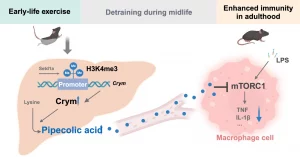Exercise has always been important for providing the body with various advantages, including cardiovascular health and boosting the immune system against infection. Additionally, regular exercise has been shown to play a role in preventing certain types of cancer and ameliorating inflammation in autoimmune diseases. These benefits seem to prevail in the short and medium-term effects. However, little is known about how exercise benefits long-term health, particularly regarding whether the benefits of childhood exercise can have a lasting impact on adult health.
Authors from the Fourth Military Medical University in China wanted to test this using an experimental model (Figure 1). One-month-old mice underwent three months of swimming training, after which training was discontinued. After reaching 15 months of age, the exercised mice were exposed to LPS to induce sepsis, and their immune response was evaluated. Compared to the sedentary mice, the exercised mice showed reduced sepsis severity, including reduced inflammatory cytokines and increased anti-inflammatory cytokines.

Figure 1: Schematic depicting long-term effects of early-life exercise on immunity. Early-life exercise training curbs inflammatory response to LPS challenge and mitigates sepsis in adulthood in mice, even after a long period of detraining. This persistent immunoregulatory effect is mainly attributed to enhanced hepatic production of pipecolic acid due to increased H3K4me3 modification at the Crym promoter. Pipecolic acid exerts a significant anti-inflammatory effect via reducing pro-inflammatory cytokines in macrophages through inhibiting mTORC1 signaling (created with BioRender.com).
The authors looked for metabolic alterations resulting from early life exercise and found out that pipecolic acid, a product of lysine metabolism, was upregulated in the liver and in the serum of exercised mice. Additionally, this enrichment was also happening in the serum of healthy volunteers before and after exercise.
To test if pipecolic acid was the molecule associated with the reduced severity in sepsis, the authors challenged mice with LPS and pipecolic acids and found that this molecule reduced inflammation and sepsis severity. Mechanistically, the authors showed that treatment with pipecolic acid inhibited mTORC1, which is a cellular energy sensor that enhances inflammatory and effector functions.
The authors showed that Crym, the key enzyme required for the conversion of lysine to pipecolic acid, was upregulated in the liver of the early-life exercised mice. The authors considered that epigenetic mechanisms were participating in this process. The authors ruled out differences in DNA methylation but found enrichment and maintanance of actiavtion mark H3K4me3 at the Crym promoter.
In summary, the study findings provide compelling evidence for the long-term benefits of exercise on human health. This work highlights the importance of incorporating regular exercise early into life habits to promote overall well-being and mitigate the risk of chronic diseases.
Journal article: Zhang, et al., 2024. Early-life exercise induces immunometabolic epigenetic modification enhancing anti-inflammatory immunity in middle-aged male mice. Nature Communications.
Summary by Eugenio Contreras Castillo










